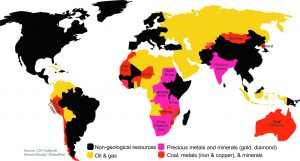If Conservation of resources goes wrong, nothing else will go right – M.S. Swaminathan

The distribution of geological resources that become the largest wealth and export income of countries in the world (Source: Simran Khosla, 2014 with modifications)
Before reading this article, let us take a quick look at what items are around us? Being in a classroom with air condition and projectors while reading this article using the latest advanced laptop. Or at home, watching television and reading this article from a smartphone in your hand, at the same time your mom is cooking using a gas stove and your dad is checking the remaining fuel in your car.
Looking further, those goods and their complements that we use daily are derived from the processing of geological resources. It is undeniable that the extraction of current geological resources is very important and cannot be separated from human life. Then, what exactly are these geological resources?
The term geological resource refers to all the solid, gas, and liquid elements originating from the earth’s crust both on the surface and below the surface with optimal concentration to be extracted. Based on the potential usage, geological resources can be classified into 3 main groups, namely:
- Material resources: that are utilized in their physical form. Those include rocks, metallic and non-metallic minerals, gemstones, and others.
- Energy resources: that are utilized to produce energy and or further needs. Those include coal, oil and gas, geothermal, groundwater, waterfalls, and others.
- Spatial resources: that are in the form of space or living space, for example land area, geomorphology, and environment.
Based on this definition, geological resources can be defined as the accumulation of rock, metal and non-metal mineral resources, coal, peat, solid bitumen, oil, natural gas, geothermal, and the environment (water and soil) existing in the earth’s crust, both on the surface and below the surface, and are able to be extracted sustainably to meet human needs.
Aside from the classification based on its potential usage, in general, geological resources are also classified as renewable and non-renewable geological resources. What are they and what resources are included in these two groups?
Renewable geological resources
Renewable geological resources can be reproduced through natural regeneration. The timespan and place for the regeneration process are varied depending on the resource types. The examples of renewable resources are water and soil. Soil regeneration is influenced by chemical, geological, hydrological, and biological processes. While water regeneration is controlled by the hydrological cycle that are influenced by solar energy, climate, and topography. Although water and soil can be regenerated, excessive extraction of renewable geological resources exceeding their capacity can cause depletion of the resources and even worse the extinction. Sustainable use of renewable geological resources requires extraction rate less than the regeneration of these resources or innovation of reusing the resources (recycling).
Non-renewable geological resources
The example of non-renewable geological resources are coal, petroleum, natural gas, rocks containing metals (iron, gold, copper, silver, lead, manganese, zinc) and non-metallic rocks. Non-renewable geological resources will be depleted when they are continuously extracted due to the long geological formation of these resources (millions of years). The use of non-renewable geological resources today will surely reduce their reserves and availability.

Indonesia as an archipelagic country has abundant geological resources, both renewable and non-renewable geological resources (read the article: Geological resources of Indonesia).
However, after reading this article, it can be concluded that the extraction of Indonesia’s geological resources should be conducted sustainably so that the environment and availability of the Indonesian geological resources could still be utilized by future generations. Moreover, the best scientific and technological approaches are needed to manage and to extract effectively and efficiently. Finally, we must actively participate in the move on protecting our nature and resources, and striving to find non-conventional sources of energy for Indonesia’s better future.
Source:
Didi Rukmana. 2012. Ekonomi lingkungan dan sumber daya alam / Didi Rukmana. Makassar : Arus Timur.
Mata-Perelló, Josep M., Mata-Lleonart, Roger, & Vintró-Sánchez, Carla. 2011. A New Classification Of Geological Resources. Dyna, 78 (170), 243-249. Retrieved April 23, 2020, From Http://www.Scielo.Org.Co/Scielo.Php?Script=Sci_Arttext&Pid=S0012-73532011000600029&Lng=En&Tlng=En.
